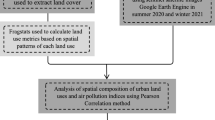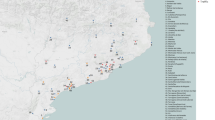Abstract
Air quality is a major concern in highly urbanised and industrialised regions, as well as rural areas. Air pollutant concentrations often exhibit significant spatial and temporal variability, depending on local sources, climate conditions and the characteristics of the built and natural environment. The strong relationship between emissions and human activities is well known: residential functions, infrastructure systems and industrial plants are the main emission sources of different pollutants, especially for PM2.5. Agriculture also produces pollutants. By contrast, forests usually act as adsorption sinks, reducing the pollution concentration. Therefore, pollutant emissions and concentration patterns present significant spatial variability due to different land uses. Moreover, the correlation between urban and territorial functions and pollution varies, sometimes by a significant amount, with different regions and scales leaving a significant gap for urban planning. The presented research aims at describing the potential correlation between different land uses and the emissions and concentrations of air pollutants, as a starting point for more in-depth studies in relation to urban and territorial transformations, the sustainable renewal of dismissed areas and the revitalisation of rural areas. By considering a territorial scale for the analysis (Pavia Province in northern Italy), we intend to underline the links (linear, direct, indirect) between land uses (residential, agricultural, and industrial) and the main air pollutants (CO2eq), as well as the degree of intensity.
Access this chapter
Tax calculation will be finalised at checkout
Purchases are for personal use only
Similar content being viewed by others
References
UNFCCC Homepage: https://unfccc.int/topics/land-use/the-big-picture/introduction-to-land-use. Last accessed 10 April 2011
Babiy, A.P., Kharytonov, M.M., Gritsan, N.P.: Connection between emissions and concentrations of atmospheric pollutants. In: Melas, D., Syrakov, D. (eds.) Air Pollution Processes in Regional Scale. NATO Science Series, vol 30. Springer, Dordrecht (2003)
Janssen, S., Dumont, G., Fierens, F., Mensink, C.: Spatial interpolation of air pollution measurements using CORINE land cover data. Atmos. Environ. 42(20), 4884–4903 (2008)
Xu, G., et al.: Examining the impacts of land use on air quality from a spatio-temporal perspective in wuhan, China. Atmosphere 7(62), (2016)
Zheng, S., Zhou, X., Singh, R.P., Wu, Y., Ye, Y., Wu, C. The spatiotemporal distribution of air pollutants and their relationship with land-use patterns in hangzhou City, China. Atmosphere 8(110), (2017)
Bashir, M.F., et al. Correlation between environmental pollution indicators and COVID-19 pandemic: a brief study in californian context. Environmental Research 187 (2020)
Zimmerman, N., et al.: Improving correlations between land use and air pollutant concentrations using wavelet analysis: insights from a low-cost sensor network. Aerosol Air Qual. Res. 20, 314–328 (2020)
Weng, Q., Yang, S.: Urban air pollution patterns, land use, and thermal landscape: an examination of the linkage using GIS. Environ Monit Assess 117, 463–489 (2006)
Zou, B., Wilson, J.G., Zhan, F.B., Zeng, Y.: Spatially differentiated and source-specific population exposure to ambient urban air pollution. Atmos. Environ. 43, 3981–3988 (2009)
Yang, J., Shi, B., Shi, Y., Marvin, S., Zheng, Y., Xia, G.: Air pollution dispersal in high density urban areas: Research on the triadic relation of wind, air pollution, and urban form. Sustainable Cities and Society 54 (2020)
Han, L., Zhao, J., Gao, Y., Gu, Z., Xin, K., Zhang, J.: Spatial distribution characteristics of PM2.5 and PM10 in Xi’an City predicted by land use regression models. Sustainable Cities and Society 61 (2020)
FAO: Emissions due to agriculture. Global, regional and country trends 2000–2018. FAOSTAT Analytical Brief Series. No 18. Rome
Cloy, M.J., et al.: Impacts of agriculture upon greenhouse gas budgets. In: Hester, R.E., Harrison, R.M. (eds.) Environmental Impacts of Modern Agriculture. Issues in Environmental Science and Technology 34, pp. 57–82. Royal Society of Chemistry, Cambridge (2012)
Feliciano, D., Slee, B., Hunter, C., Smith, P.: Estimating the contribution of rural land uses to greenhouse gas emissions: A case study of North East Scotland. Environ. Sci. Policy 25, 36–49 (2013)
Pezzagno, M., Richiedei, A., Tira, M.: Spatial planning policy for sustainability: analysis connecting land use and GHG emission in rural areas. Sustainability 12 (2020)
WHO Homepage: https://www.who.int/news-room/feature-stories/detail/what-are-the-who-air-quality-guideline. Last accessed 10 April 2022
Feng, H., Zou, B., Tang, Y.: Scale and region-dependence in landscape-PM2.5 correlation: implications for urban planning. Remote Sens. 9 (2017)
Briganti, G.: Un’introduzione Allo Studio Della Dispersione di Inquinanti in Atmosfera in Condizioni di Calma di Vento. ENEA: Pisa, Italy (2007)
Istat: SDGs 2021 Report. Statistical information for Agenda 2030 in Italy. Available online: https://www.istat.it/storage/rapporti-tematici/sdgs/2021/Rapporto-SDGs-2021.pdf
Caserini, S., Giani, P., Caspani, F., Santoro, D., Cacciamani, C., Lonati, G.: Influence of climate change on the frequency of lapse rate inversion and stagnation events in Po valley: historical trend and future projections. Ingegneria dell’Ambiente 3(1) (2016)
Quality report of the air of the province of Pavia: https://www.arpalombardia.it/qariafiles/RelazioniAnnuali/RQA_PV_2020.pdf
Maranzano, P.: Air Quality in Lombardy, Italy: an overview of the environmental monitoring system of ARPA Lombardia. Earth 3(1), 172–203 (2022)
European Commission: Closing the mineral cycles at farm level. Good practices to reduce nutrient loss in the Lombardy region (Italy). available online https://ec.europa.eu/environment/water/water-nitrates/pdf/leaflets/Leaflet_Lombardy_EN.pdf
INEMAR Homepage: https://www.inemar.eu/xwiki/bin/view/Inemar/HomeLombardia. Last accessed 01 April 2022
Geoportale Lombardia Homepage: https://www.geoportale.regione.lombardia.it/en-GB/home. Last accessed 02 April 2022
INEMAR Homepage: https://www.inemar.eu/xwiki/bin/view/Inemar/. Last accessed 10 April 2022
Corinair: https://www.eea.europa.eu/help/glossary/eea-glossary/corinair. Last accessed 10 April 2022
INEMAR Emission factors: https://www.inemar.eu/xwiki/bin/view/InemarDatiWeb/I+fattori+di+emissione. Last accessed 10 April 2022
Gogtay, N.J., Thatte, U.M.: Principles of Correlation Analysis. J Assoc Physicians India. 65(3), 78–81 (2017)
Bouslaugh, S., Watters, P.A.: Statistics in a Nutshell, 1st ed., pp. 176–179. O’Really Media, Sebastopol, USA (2008)
Nettleton, D.: Commercial Data Mining: Processing, Analysis and Modeling for Predictive Analytics Projects (2014)
Author information
Authors and Affiliations
Corresponding author
Editor information
Editors and Affiliations
Rights and permissions
Copyright information
© 2022 The Author(s), under exclusive license to Springer Nature Switzerland AG
About this paper
Cite this paper
De Lotto, R., Moretti, M., Venco, E.M., Bellati, R., Monastra, M. (2022). Lack of Correlation Between Land Use and Pollutant Emissions: The Case of Pavia Province. In: Gervasi, O., Murgante, B., Misra, S., Rocha, A.M.A.C., Garau, C. (eds) Computational Science and Its Applications – ICCSA 2022 Workshops. ICCSA 2022. Lecture Notes in Computer Science, vol 13382. Springer, Cham. https://doi.org/10.1007/978-3-031-10592-0_10
Download citation
DOI: https://doi.org/10.1007/978-3-031-10592-0_10
Published:
Publisher Name: Springer, Cham
Print ISBN: 978-3-031-10591-3
Online ISBN: 978-3-031-10592-0
eBook Packages: Computer ScienceComputer Science (R0)




